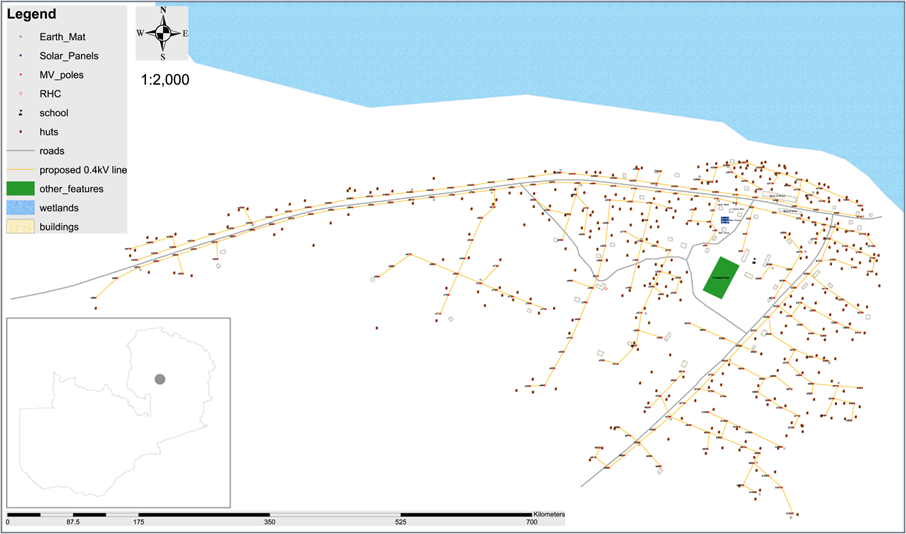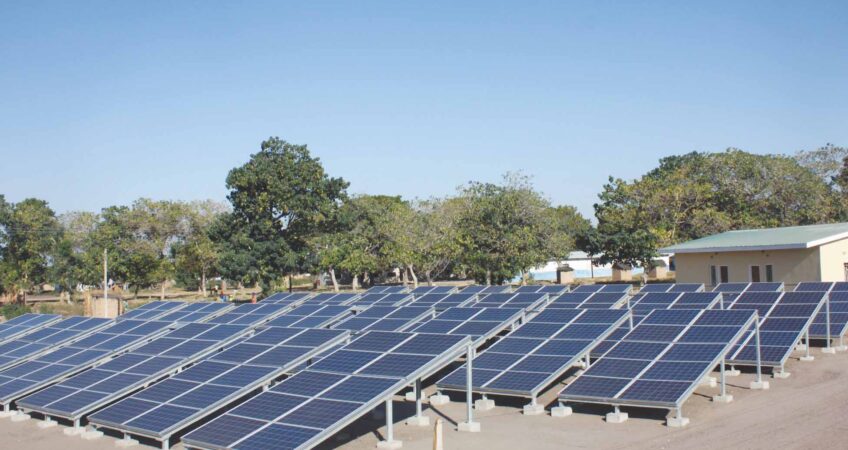Mpanta Solar PV Project in Zambia
In our latest blog, Nandi Mbazima writes on the Mpanta solar mini-grid project in Zambia.
As the first community-based renewable mini-grid developed in Zambia, the Mpanta Solar PV Project was developed as a demonstration project to showcase a viable inclusive governance scheme that can provide and sustain electricity to a rural community. While the community project was initially able to achieve its aspiration of providing lighting and basic energy services to the residents of Mpanta village, it ultimately was not a sustainable venture and is not operational today. However, there are some important learnings that can be gleaned from its operative years, which form the basis of this blog.
Figure 1: Schematic of the Mpanta solar mini-grid, and its location with Zambia (inset)

Source: Muhoza and Johnson, 2018.
The project was the culmination of a partnership between donor agencies and Zambian government departments that sought to encourage community participation. Following the establishment of the Mpanta mini-grid system, the operation and management of the mini-grid and its services was turned over to the Kapita Cooperative Society (KCS), a nonprofit organsation that has a mission to “promote rural compulsory community participation in multiple economic ventures that will result [in] maximum beneficiary satisfaction for sustainable development.”[1] While the project was to some extent fruitful in providing basic energy services to Mpanta Village, it did not account for the predominantly socio-economic challenges in Mpanta that made the system’s functioning incongruous with the village’s practices and views. This prevented the realization of a healthy, equitable, and sustainable community-governed energy system.
This stemmed from several issues.
The first set of issues are economic: Mpanta village is primarily a fishing community, with fishing activities providing income for many residents in the community. As a seasonal occupation, hampered by government-imposed fishing bans, this has meant that a large number of end users connected to the grid have been unable to sustain consistent payments for service provision. Additionally, fishing as a vocation does not yield high incomes for fishermen that tend to be the primary breadwinner of their households. The compounded effect has meant that many households have struggled to pay and to maintain the tariffs charged through the Mpanta grid and have subsequently been disconnected.
The second set of issues are structural: Within Mpanta village, decision-making responsibilities around finances are largely attributed to men. In Mpanta, this has had repercussions for what appliances are prioritized and what pursuits get precedence over electric appliances and devices. This is correlated with the traditional roles ascribed to men vs women within the community; women largely assume responsibilities and day-to-day tasks that are further down the energy ladder. This includes, collecting firewood, cooking, cleaning, and household care. In the instance where finances are not funneled to the purchase of appliances such as electric stoves, washing machines or even sewing machines, but rather to lighting, television sets, and radios, this can present skewed benefits to men and children over women through electrification. This manifestation has been observed within Mpanta households, and gender-positive productive uses of energy at the household level need to actively be considered in similar energy ventures in the future.
The third set of issues are related to attitudes: at the start of operations of the Mpanta solar mini-grid, customers were connected to the system for free, for an initial period of time, to encourage uptake to the services provided. After the initial period ended, customers were then required to pay a connection fee and wiring fee. Many believed that this was not well communicated by the project developers with energy customers, and this was a contentious issue between the two interest groups.
The last issue is financial: the project was not in a financial position to cover the replacement of batteries that was needed at the end of their useful life, and this was a major long-term problem. This is a critical component in the success of off-grid solutions that rely on solar equipment. The ability – not just the willingness – to pay of the targeted customer base is a fundamental aspect of tariff pricing models that should not be taken lightly, and additional avenues of financial support should be a decisive factor where communities may need a period of time to attain self-sustenance status where tariffs are concerned.
Figure 2: Mpanta solar mini-grid

Source : http://www.daily-mail.co.zm/rea-energy-transforming-rural-lives/
Despite the eventual discontinuation of the Mpanta solar mini-grid, important lessons were learned around addressing the socio-economic and societal conditions of targeted rural communities when designing the electrification strategy, even in instances where the inclusion of community governance may not cause a management process that reflexively adjusts to community dynamics. For its unfortunate conclusion, the Mpanta project still yielded positive effects trialing and learning from the first solar mini-grid plant, in spurring the development of further small-hydro and solar mini-grids in Zambia, and in promoting and creating new productive activities that contributes to knowledge, innovation, and livelihood improvement.[2]
Author: Nandi Mbazima
Reference:
Muhoza, C. and Johnson, O. W. (2018) ‘Exploring household energy transitions in rural Zambia from the user perspective’, Energy Policy. Elsevier Ltd, 121, pp. 25–34. doi: 10.1016/j.enpol.2018.06.005.
[1] https://kafitampcs.wixsite.com/kafitampcs/about_us
[2] https://www.unido.org/sites/default/files/2017-03/Minigrid_report_Jan2017.v19_FINAL29906_0.pdf

